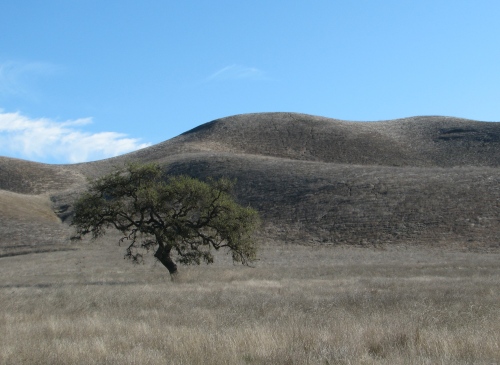The Sedgwick Reserve is part of the University of California Natural Reserve System and is used primarily for research and education, however once a month the site is open to the public. It is at these times that not only does one have an opportunity to see this remarkable land but also experience in part what goes on at the reserve.
The roughly 5,900 acre reserve is largest of 36 sites owned by Regents of the University of California and one of seven that are managed by UCSB along with sites at the Carpinteria Salt Marsh, Coal Oil Point and on Santa Cruz Island. The reserve is located in the Santa Ynez Valley and stretches north through the foothills of the San Rafael Mountains, and from where the road first enters the site cresting Figueroa Canyon and throughout much of the hike the views are framed in the distance by Grass Mountain, Zaca Peak, Figueroa Mountain and Ranger Peak stretching majestically west to east.
The land borders the Los Padres National Forest to the north and is home to a wide range of plants and animals representative of the area including coast live oak woodland, valley oak savanna, native grassland and chaparral. In fact the photo gallery on their website at one time included images of black bear, bobcat, mule deer, mountain lion and golden eagles all caught on camera as they visited the various water troughs on the property. The Sedgwick Reserve offers docent led hikes on the second Saturday of each month, weather permitting. There are generally three interpretive hikes available, the easier Mesa Loop Hike that is about 1.5 miles round trip, the moderate Blue Schist Hike which includes a visit to Little Pine Fault and is about 2.5 miles round trip and a longer hike that leads through the Northeast corner of the reserve and is about 4.5 miles round trip. All hikes start at the Field Station buildings. On site registration begins at 8:30AM and the hikes generally conclude around noon, afterwards visitors are welcome to stay and picnic on the site.
A reservation is required to visit the Sedgwick Reserve and arrangements can be made by calling 686-1941. The reserve is located at the end of Brinkerhoff Avenue near Santa Ynez and directions are provided as part of the reservation process along with what to bring and where to meet. There is no charge for the hike, however a suggested donation of $5 helps support the reserve’s outreach programs.
I opted for the middle hike along the Blue Schist Trail having heard that it offered a good mix of hiking and teaching, however to accommodate the group the docent took us along a different route that led us past the pond and over into neighboring Windmill Valley and then along a loop that led us past a site that the Chumash had used intermittently. This seasonal camp near the confluence of Figueroa and Lisque Creeks was considered a stopping place between the nearby villages of Soxotonokmu’ to the north, on what is now the Midland property and Kalawashaq’ near the Santa Ynez River to the south.
In 1845, following the Mission period in California, the land became part of the Rancho La Laguna land grant and was used primarily for ranching and cattle grazing. The property then passed through the hands of a number of owners until it was purchased in 1952 by rancher and sculptor Francis “Duke” Sedgwick and his wife Alice. In 1997 the land became part of the UC Natural Reserve System when the Sedgwicks bequeathed a large portion of the ranch to the University of California; the remaining land, including the buildings, was acquired through the efforts of the Land Trust for Santa Barbara County and other supporters.
Throughout the hike I was struck by how knowledgable the volunteer docents are regarding the local natural history and would later learn that they go through extensive training before being allowed to lead interpretive hikes. This emphasis on teaching is to me a direct reflection of the reserve’s commitment to working with and learning from the land, and as such they are able to draw in a lot of talented volunteers.
The docent from my hike clearly had an extensive knowledge of the local birds and we were fortunate on our hike to see Red Tail Hawks, Kites and Kestrel and learn about their differences, what they ate and how they related to one another. At times the hike felt more like a walking classroom with the questions asked by others adding to the range of topics covered. In fact it would be hard not be inspired to come back for another visit and see more of the site and learn more about the local flora and fauna. The reserve has also recently hit on a happy medium of making the docent training classes open to the public, by donation. Now anyone who is interested can audit classes on a wide range of topics including geology, birding, wildflowers, general ecology, plants and animals; classes are typically led by university professors or local experts and include on site field trips. One can attend all of the classes or just those that appeal to them and represent an opportunity to learn alongside the docents without necessarily committing to being a volunteer.
Regardless of which hike you go on you will get to see some great scenery and likely learn something new about our local backcountry.
This article originally appeared in section A of the December 17th, 2011 edition of the Santa Barbara News-Press.














Leave a comment